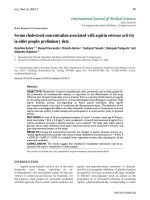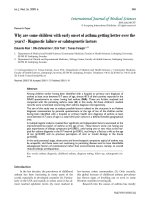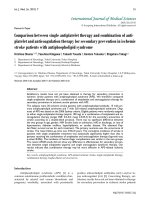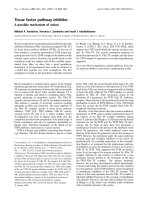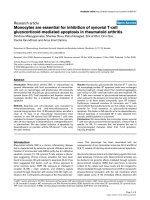Báo cáo y học: "Why are some children with early onset of asthma getting better over the years" -aneuploid-prostate-cancer-cells-after-tmz-tmz-bioshuttle-treatment.html#post143974
Bạn đang xem bản rút gọn của tài liệu. Xem và tải ngay bản đầy đủ của tài liệu tại đây (374.25 KB, 10 trang )
Int. J. Med. Sci. 2009, 6
348
I
I
n
n
t
t
e
e
r
r
n
n
a
a
t
t
i
i
o
o
n
n
a
a
l
l
J
J
o
o
u
u
r
r
n
n
a
a
l
l
o
o
f
f
M
M
e
e
d
d
i
i
c
c
a
a
l
l
S
S
c
c
i
i
e
e
n
n
c
c
e
e
s
s
2009; 6(6):348-357
© Ivyspring International Publisher. All rights reserved
Research Paper
Why are some children with early onset of asthma getting better over the
years? - Diagnostic failure or salutogenetic factors
Eduardo Roel
1
, Olle Zetterström
2
, Erik Trell
1
, Tomas Faresjö
1
1. Department of Medical and Health Sciences/Community Medicine, Faculty of Health Sciences, Linköping University,
SE-581 83 Linköping, Sweden.
2. Department of Clinical and Experimental Medicine /Allergy Centre, Faculty of Health Sciences, Linköping University,
SE-581 83 Linköping, Sweden.
Correspondence to: Tomas Faresjö, Assoc Prof., Department of Medical and Health Sciences / Community Medicine,
Faculty of Health Sciences, Linköping University, SE-581 83 Linköping, Sweden. Telephone: +46 13 22 20 00; Fax: +46 13 22 40
20; E-mail:
Received: 2009.07.09; Accepted: 2009.11.17; Published: 2009.11.19
Abstract
Among children earlier having been identified with a hospital or primary care diagnosis of
asthma at least once between 0-7 years of age, almost 40 % of their parents reported in the
ISAAC-questionnaire as never having had asthma (NA). These are further analysed and
compared with the persisting asthma cases (A) in this study. All these children’s medical
records were scrutinized concerning their asthma diagnose retrospectively.
The aim of this study was to analyse possible factors related to the outcome in an Asthma
diagnosis reassessment by parental questionnaire at the age of ten of the children earlier
having been identified with a hospital or primary health care diagnosis of asthma at least
once between 0-7 years of age in a total birth-year cohort in a defined Swedish geographical
area.
A multiple logistic analysis revealed four significant and independent factors associated to the
improvement/non-report of asthma at the age of ten. These factors were; not having any
past experiences of allergic symptoms (p<0.0001), only having one or two visits at the hos-
pital for asthma diagnosis in the 0-7 interval (p=0.001), not living in a flat but a villa at the age
of ten (p=0.029) and no previous perception of mist or mould damage in the house
(p=0.052).
In the early postnatal stage, obstructive and bronchospastic symptoms typical of asthma may
be unspecific, and those cases not continuing to persisting disease tend to have identifiable
salutogenetic factors of constitutional rather than environmental nature, namely, an overall
reduced allergic predisposition.
Key words: asthma diagnosis, childhood asthma, diagnose setting, follow-up, salutogenetic fac-
tors.
Introduction
In the last decades, the prevalence of childhood
asthma has been increasing in many parts of the
world, especially in developed countries (1). Particu-
larly in the USA and mainly in urban areas it has al-
most reached epidemic levels (2), most marked in
low-income urban communities (3). Only recently,
this global increase of childhood asthma prevalence
has shown signs of levelling out or even in some
Western countries reversing (4).
Research into the causes of asthma has mostly
Int. J. Med. Sci. 2009, 6
349
focused on potential risk factors in the environment
(5). Childhood asthma is of a multi-factorial nature
which indicates that we must have a broader per-
spective to gain a better understanding of its complex
aetiology. In the last years, attention has also been
directed towards protective factors. In allergic disor-
ders this research has been focused upon factors that
could enhance the development of tolerance to aller-
gens which were previously encountered early in life,
but are now disappearing in modern affluent societies
(6). However, this so called hygiene hypothesis based
on the role of infection in the education of the immune
system of young children, can not solely explain the
trends in asthma prevalence or account for potential
environmental influences on the asthma risks.
Asthma could also be seen as a respiratory maladap-
tation to modern lifestyles and to our increasingly
artificial habitats and habits; not the least a progres-
sive decrease of general physical activity (7,8).
Wheeze is common throughout childhood and
"transient early wheezing" predominates during the
first years of life, although it decreases as children age
(9). Studies have shown that abnormalities of neonatal
airway function which precede transient wheezing in
early childhood do not predict adult obstructive lung
disease (10). A longitudinal population-based cohort
study has shown that the earlier the age at onset, the
greater the chance of relapse (11). So, there is also a
chance that some children with wheezing symptoms
in early life have outgrown their childhood asthma as
teenager or as adults, but asthmatic children who
continue to wheeze as adults have poorer baseline
spirometry than healthy controls (10). Epidemiologi-
cal reports have also demonstrated that a certain per-
centage of subjects with apparently outgrown atopic
asthma remain asymptomatic without needing ther-
apy for the rest of their lives, but asthma remission
also does exist (12). The more severe the asthma is in
childhood the more likely it is that the disease will
persist in adulthood and many teenagers who seem to
be free of symptoms do, in fact, have persistent
asthma (13).
The overall and general target for epidemiol-
ogical studies is to shed light over potential risk fac-
tors for disease (14). More rarely are questions raised
of possible factors that might support health or re-
covery from disease. This alternative research per-
spective is referred to as a salutogenetic approach to
health (15,16). A salutogenetic perspective of child-
hood asthma could thus be to focus on factors aiding
children with asthma to getting better over the years.
The aim of this study was to analyze possible
factors related to the outcome in an Asthma diagnosis
reassessment by parental questionnaire at the age of
ten of the children earlier having been identified with
a hospital or primary health care diagnosis of asthma
at least once between 0-7 years of age in a total
birth-year cohort in a defined Swedish geographical
area.
Methods
Study design
A birth cohort of all children born 1990 (total N =
2 104 children) from a defined Swedish region
(County Council of Östergötland) with 150 000 in-
habitants (of which about 125 000 urban), born at the
University Hospital in Linköping (which is the only
somatic hospital in the region and where all births
occurred), except those suffering neonatal death and
those living outside the region, were included in the
study. At the age of seven, all of them still living in the
region were included in a follow-up of their comput-
erised medical records, which were examined for the
occurrence of the diagnosis asthma (ICD-9:493) at the
Department of Paediatrics at the University Hospital
and at all 14 PHC Units and at the private Paediatri-
cians in the region. Of the initial total birth cohort, 82
% (n=1 752 children) were still living in the region at
the age of seven. Children born in 1990 that had
moved into the study-area after 1990 were not in-
cluded in the study (17).
Data of perinatal and obstetric factors as well as
some social factors at baseline (1990) were obtained by
investigations of the maternal medical records at the
University Hospital, including PHC data of the
statements made by the mid-wife in her records of the
check-up of the mothers during the pregnancy (17). In
the follow-up at the age of seven, n= 191 children of
the defined remaining birth cohort were found with a
documented asthma diagnosis at one or more occa-
sions over the 0-7-year interval in the medical records
(18,19).
A further data collection was made through a
manual scrutiny by one of us (E.R.) of all
asthma-relevant medical records at the Department of
Paediatrics at the University Hospital for all of the
n=63 children in the NA group. This follow-up
analysis mainly focused on diagnosis setting, possible
differential diagnoses, number of visits and medical
treatment given to these children up to the age of ten.
Subjects
At the age of 10 the parents of these n=191 chil-
dren with a documented asthma diagnosis, were sent
the International Study of Asthma and Allergies in
Childhood (ISAAC) questionnaire (20,21) concerning
asthma history, symptoms, heredity, socio-economic
factors and environmental exposure. The response
Int. J. Med. Sci. 2009, 6
350
rate to this postal questionnaire was 83 % (n=159).
Only in 60.4% of them (n=96), the parents confirmed
that their child ever had asthma, whereas in 39.6%
(n=63) they answered “No” to this question. These
two groups, labelled A (confirmed asthma diagnosis
at the age of 10) and NA (negated asthma diagnosis at
the age of 10), are further analysed in the present pa-
per. A flow chart of the eligible children and those
participating is presented in figure 1.
Figure 1: Flow chart of the eligible children in the study.
Statistics
All data were stored in a common database and
statistically analysed using the SPSS version 14.0
programme (SPSS Inc., Chicago, IL, USA). Signifi-
cance of differences was assessed by the Chi
2
-method
for categorical variables and for continuous variables
by Spearman’s non-parametric correlation and the
2-sided ANOVA-test. Odds ratios and 95 % confi-
dence intervals were also calculated and a p-value of
less than p<0.05 was considered statistically signifi-
cant.
A multiple logistic regression analysis was made
to determine the independent variables that positively
might affect the chance of not reporting asthma at the
age of 10. Prior to this analysis a correlation matrix
was initially made for all independent variables in
order to determine which indicators to be included in
the final model. For those variables that were in-
ter-correlated and represented the same factor, only
those which were most strongly statistically corre-
lated to the dependent variable (i.e. reporting asthma
or not reporting asthma at the age of 10) and least
highly inter-correlated, were included in the final
multiple logistic regression model. Odds ratios and
95% confidence intervals were estimated for variables
included in the multivariate logistic regression analy-
sis.
Ethical approval
The study was approved 1996 (Dnr. 96-164) by
the Ethical Committee at the Faculty of Health Sci-
ences, Linköpings Universitet, Sweden.
Results
Of the previously well documented children
with asthma diagnosis (n=159), the parents to 39.6 %
of them (n=63) reported in the ISAAC questionnaire
at the age of ten that their child never had asthma
(group NA), while 60.4 % (n=96) confirmed their
children’s asthma diagnosis (group A). The propor-
tion of boys and girls in the two groups were quite
similar (p=0.866) as shown in table 1. There were no
differences in having younger or older siblings in the
groups. A slight difference was seen between the two
groups concerning socio-economic factors in which
the proportion of blue collar fathers and mothers
tended to be a bit higher in group A than group NA.
The number of children living in a villa rather than an
apartment was however significantly higher (p=0.005)
at the age of ten in group NA than in group A. This
proportion increased from 68.3% at the age of three to
87.3% at the age of ten for group NA, and from 62.5%
at the age of three to 66.7 at the age of ten for children
in group A. The proportion of children living in urban
areas tended to be higher in group NA than in group
A both at the age of three and at the age of ten.
Different residential and environmental expo-
sures in the groups are shown in table 2. Exposure to
smoking in the family tended to be slightly higher in
group NA than in group A. Present or previous ex-
posure to pet allergens in the family tended to be
higher in group NA for cat and dog and significantly
higher (p=0.008) concerning exposure for other ani-
mals with furs. Also horse riding of the child or by
other members in the family tended to be higher in
group NA than in group A. Present or previous resi-
dential environmental exposure like; reports of mould
damage, unusual or bad smell or dry air inside the
house were significantly more frequent reported in
group A than in group NA.
Int. J. Med. Sci. 2009, 6
351
Table 1: Social and demographic factors among N=159 children confirming (group A) respective neglecting their asthma
diagnosis (group NA) at the age of 10.
Int. J. Med. Sci. 2009, 6
352
Table 2: Residential and environmental exposure among children (N=159) confirming (group A) respective neglecting
(group NA) their asthma diagnosis at the age of 10.
There was no difference (p=0.412) in the mean
birth weight of children in group A: 3 387.3 grams (+-
650.2 gr) compared to the children in group NA: 3
475.3 grams (+-673.5 gr). Neither were there any sta-
tistical significant differences between the two groups
concerning the perinatal and obstetric factors meas-
ured, like age of mother at delivery, first time preg-
nancy, and gestational week, time between labour and
birth or possible events of complications at delivery.
Reports of heredity for asthma and allergy
among children confirming (group A) respective ne-
gating (group NA) their asthma diagnosis are shown
in table 3. Heredity for asthma and allergy in the
family at child birth as well as reported asthma, aller-
gic rhinitis and eczema in the family when the child
was ten years old, were all significantly more frequent
among group A than group NA. However, also a
substantial fraction of the children in group NA re-
ported heredity for these diseases.
Figure 2 shows the number of registered health
care visits with a diagnosis of asthma from birth up to
the age of seven for the children in group A and group
NA. The NA group had significantly (p<0.0001) fewer
health care visits than group A. The mean age when
the asthma diagnosis was set was significantly lower
(p=0.001) in the children in group NA than in group
A, as shown in figure 3. However, there was no sig-
nificant difference (p=0.385) between the two groups
whether the asthma diagnosis was set at the Univer-
sity Hospital or in PHC. The asthma diagnosis was set
at the Paediatric clinic at the University Hospital for
91.4% of the children in group A and for 95.1% of the
children in group NA, the others were diagnosed in
PHC.


